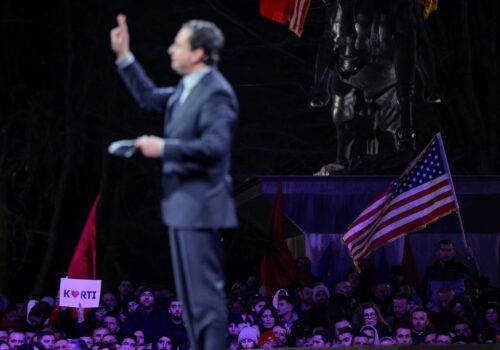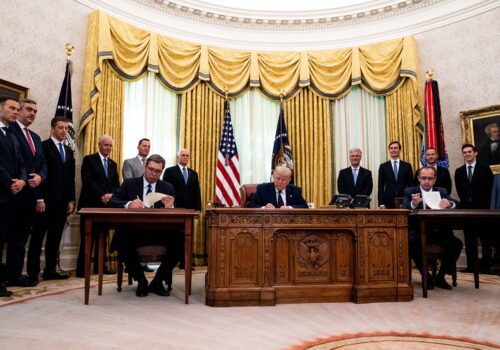
The recently renewed push for a peace agreement between Kyiv and Moscow is once again testing Russian President Vladimir Putin’s willingness to abandon his maximalist goal of fully subjugating Ukraine. The previous failure to get Putin to negotiate earlier this year led the West to intensify energy sanctions against Russia, while Moscow engaged in nuclear saber-rattling and probed NATO territory through aircraft and drone incursions, as well as hybrid attacks on European infrastructure.
Overall, the prospects for peace appear grim: In October, a US intelligence assessment reportedly concluded that Putin has “dug in” and is committed to a long war. And NATO Secretary General Mark Rutte has warned that even if there was a settlement over Ukraine, Moscow was preparing for a “long-term confrontation” with the West and could develop the capabilities to attack NATO in five years. If these current talks run break down, expect renewed escalation.
In part concerned about strategic divergence with Washington—especially in the context of US resources moving to the Asia-Pacific to deter Chinese aggression against Taiwan—European NATO members pledged in June to raise defense spending to 5 percent of their gross domestic product (GDP). And in October, the European Union (EU) approved the €800 billion “Readiness 2030” program to boost defense investment and industrial capacity.
The prospect of a prolonged, wider European war in the coming years is reshaping strategic calculations in Europe’s vulnerable “gray zones”—especially the Balkans. British officials have described the Balkans as the Kremlin’s “next playground,” a pressure point that could divert Western resources from NATO’s eastern flank. Because Russia is geographically distant from the Balkans, it has and will continue to rely on its partners—militarily-neutral Serbia and pro-Russian Serbian proxies around the region—to agitate and reopen the question of the regional borders set by the West after the 1990s wars in Kosovo and Bosnia and Herzegovina.
NATO has deterrence, but ‘everyone is preparing for war‘
So far, NATO countries have limited Russian troublemaking in the Balkans. In Bosnia and Herzegovina, for example, Milorad Dodik, the Kremlin-friendly former president of Republika Srpska, repeatedly threatened the entity’s secession from Bosnia and Herzogovina only to retreat after Western pushback. And in 2023, when Belgrade-backed Serbs led by Milan Radojičić launched an armed insurgency in northern Kosovo, Kosovo’s police repelled the attack within a day while NATO—which controls Kosovo’s borders—drew clear red lines to deter Serbia’s military involvement.
Meanwhile, Belgrade has maintained plausible deniability from Dodik’s and Radojičić’s actions, conveniently gaining leverage in the West as a “moderating force.” Serbia has also sought to ease Western concerns over its intentions by purchasing French warplanes, supplying weapons to Ukraine, and offering the West access to its lithium reserves.
Yet since 2022, Serbian President Aleksandar Vučić has notably avoided steering Serbian society toward the West, despite Russia’s aggression in Ukraine providing an opening to do so. On the contrary, an International Republican Institute poll published in September found that in a country where the government tightly controls media narratives, 78 percent of Serbs view Putin favorably and only 6 percent see Russia as solely to blame for the war.
Russian proxies continue to use Serbian territory for disruptive operations. Moscow favorite Aleksandar Vulin—who was discharged as Serbia’s intelligence chief two years ago under Western pressure—actively promotes the “Serbian World” project to unite Serbs across the region. Radojičić enjoys state protection, despite NATO calls for accountability over the attack on Kosovo. Officers from Russia’s Federal Security Service (FSB) are reportedly receiving Serbian citizenship with expedited procedures, enabling them to travel to Europe visa-free. And earlier this year, Russia even reportedly used Serbia as a base to train saboteurs to interfere in Moldova’s elections.
Serbia’s neighbors are growing increasingly wary of Belgrade’s continued ties to Russian proxies and its major military build-up over the past decade. In the event of a war between Russia and the West, neighbors worry that Serbia would use the opportunity to enact its own designs on the region. Serbia has military preponderance—it is not only the largest country in the Balkans, but also the only one spending at least 2 percent of its GDP on defense, dwarfing Kosovo’s spending by tenfold.
In line with the broader rearmament wave throughout Europe, several of Serbia’s neighbors are now ramping up their defense spending and taking joint steps to strengthen deterrence. Kosovo, for example, is planning major investments in drone and ammunition production, largely with Turkish support. In March, Albania, Croatia, and Kosovo signed a defense cooperation pact to boost interoperability, pursue joint military investments, and coordinate the procurement of arms, including US weaponry.
Earlier this year, the regional pact triggered a furious reaction from Vučic, who cast it as a sign of aggression against Serbia. Then in September, he responded with Serbia’s largest-ever military parade, displaying a mix of Western, Russian, Iranian, and Chinese equipment. In October, when it was announced that Turkey had supplied Kosovo with Skydagger kamikaze drones, Vučić posted an unusually harsh tirade against Turkish President Recep Tayyip Erdoğan, accusing him of “dreaming to restore the Ottoman Empire.”
Vučić’s extreme sensitivity to his neighbors’ military upgrades only reinforces their doubts about his long-term intentions. In October, Vučić remarked that “since everyone is preparing for war. . . it means there will be one”—a statement widely perceived as a threat in the region.
Insulating the Balkans from a Russian escalation
Much of this regional fearmongering is driven by domestic politics. Vučiċ’s military parades and his emphasis on threats from neighbors conveniently diverts attention from the mass protests that have shaken his rule. Regional military build-ups also have other geopolitical motives, such as securing political favor from countries through arms purchases. In Albania, for instance, defense spending is also seen as a chance to rebuild an industrial base long abandoned after it shut down its communist-era plants.
Some may therefore be tempted to downplay the motives behind the regional military build-up and argue that short-term deterrence against attempts to change Balkan borders remains strong. NATO and the EU still have decisive leverage, and the region’s fresh memory of war is a powerful restraint. Trump’s “peace through strength” approach may also have curbed troublemaking in a region reliant on US security.
But a broader war—one Europe is now arming for—would erode these deterrence factors, deepen security dilemmas, and heighten the risk of miscalculation, creating openings for Russia to incite and enable a new front. The United States and its European partners must therefore use this moment to insulate the Balkans from Moscow’s leverage.
Serbia’s continued nonalignment remains the core problem, giving Russia room to operate and fuel revisionism in the region. Vučić’s geopolitical balancing is the oxygen of his rule: it lets him coerce the West by casting himself as the guarantor of stability. The West’s tolerance for this has enabled democratic backsliding in Serbia and stalled the prospects of EU accession for Western Balkan countries, a goal that was originally intended to make the region’s borders irrelevant and sustain peace.
There are signs that the West is moving to constrain Vučić’s maneuvering. The Trump administration’s decision last month to push Gazprom out of Serbia’s energy sector and end sanctions exemptions on the country’s oil and gas companies is a good start to reduce Belgrade’s dependency on Moscow. EU officials are also speaking more plainly about Serbia’s trajectory and emphasizing the costs of Vučić’s policies. Moreover, Brussels is now accelerating the EU path of neighboring Albania and Montenegro while sidelining Serbia, making clear the opportunity costs of nonalignment.
Going forward, the United States should continue supporting allies in the region that are investing in their own defense, enabling them to become security contributors and to deter threats by increasing the costs of aggression. But nothing will reduce the risk of future escalation in the region more than the consolidation of the region’s security architecture. Getting Kosovo recognized by Serbia and fully embedded in Western security structures such as NATO, for example, would be a regional game changer.
Agon Maliqi is a nonresident senior fellow with the Atlantic Council’s Europe Center. He is a political and foreign policy analyst from Pristina, Kosovo.
***
The Western Balkans stands at the nexus of many of Europe’s critical challenges. Some, if not all, of the countries of the region may soon join the European Union and shape the bloc’s ability to become a more effective geopolitical player. At the same time, longstanding disputes in the region, coupled with institutional weaknesses, will continue to pose problems and present a security vulnerability for NATO that could be exploited by Russia or China. The region is also a transit route for westward migration, a source of critical raw materials, and an important node in energy and trade routes. The BalkansForward column will explore the key strategic dynamics in the region and how they intersect with broader European and transatlantic goals.
Further reading
Thu, Oct 2, 2025
What the looming verdict in Thaçi war crimes trial could mean for Kosovo, the Balkans, and beyond
New Atlanticist By Agon Maliqi
No matter its final verdict, the current case in The Hague against Kosovar politician Hashim Thaçi is likely to have wider repercussions.
Thu, Sep 18, 2025
Why did the US suspend its strategic dialogue with Kosovo? And what’s next?
New Atlanticist By
Atlantic Council experts answer four pressing questions about a surprise recent announcement by the US Embassy in Pristina.
Mon, Aug 25, 2025
Trump should kickstart Kosovo-Serbia talks into making real progress
New Atlanticist By Agon Maliqi
The Trump administration has an opening to reinvigorate dialogue between Kosovo and Serbia, but it must avoid the mistakes of past mediation processes.
Image: Serbian army military police rides on APCs during a military parade in Belgrade, Serbia, September 20, 2025. REUTERS/Zorana Jevtic.




